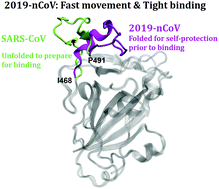Tracing the driving forces responsible for the remarkable infectivity of 2019-nCoV: 1. Receptor binding domain in its bound and unbound states†
Abstract
The pandemic of COVID-19 has posed an urgent need to learn the dynamics of the virus and the mechanism of its contagion of host cells. By means of molecular dynamics simulations, this work addressed the behavior of 2019-nCoV in two aspects: the binding affinity of its receptor binding domain (RBD) with ACE2, and its potential conformation preferences in its unbound state. The results showed that the RBD of 2019-nCov bound much stronger with ACE2 than that of SARS-CoV due to a better organized hydrogen bond network between the former pair with most of the residues at the contact interface sharing the responsibility to hold the pair tightly. This is in contrast to the case of SARS-CoV, which strongly relied on the residues at the ends of the cleft. In its unbound state, the RBD of 2019-nCoV was found to fold part of its receptor binding motif (RBM) into a helical conformation and flip into a concave to minimize its contact with the external environment. This has the biological implication that the virus may achieve higher translational motion in the condensed phase and have a higher chance of survival by avoiding capture by the immune system before reaching its target receptor.



 Please wait while we load your content...
Please wait while we load your content...